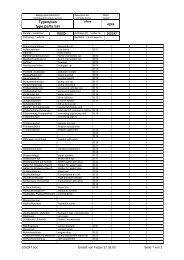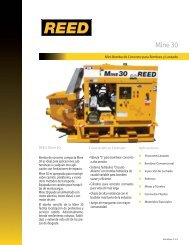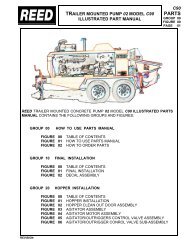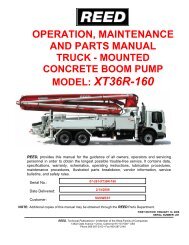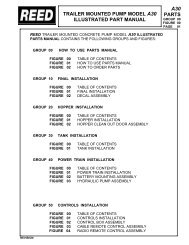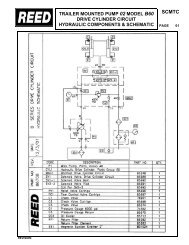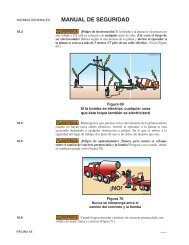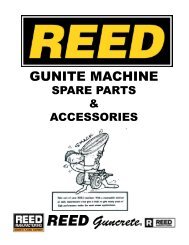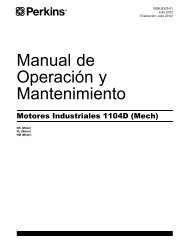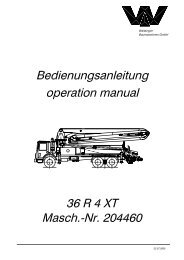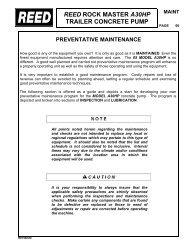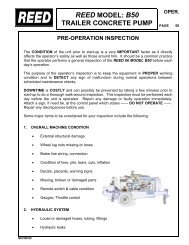Perkins Motor Operation and Maintenance Manual (English) - REED
Perkins Motor Operation and Maintenance Manual (English) - REED
Perkins Motor Operation and Maintenance Manual (English) - REED
Create successful ePaper yourself
Turn your PDF publications into a flip-book with our unique Google optimized e-Paper software.
SEBU8325-01 61<br />
<strong>Maintenance</strong> Section<br />
Engine Air Cleaner Element (Dual Element) - Clean/Replace<br />
2. The secondary air cleaner element should be<br />
removed <strong>and</strong> discarded for every three cleanings<br />
of the primary air cleaner element.<br />
Note: Refer to “Cleaning the Primary Air Cleaner<br />
Elements”.<br />
3. Cover the air inlet with tape in order to keep dirt<br />
out.<br />
4. Clean the inside of the air cleaner cover <strong>and</strong> body<br />
with a clean, dry cloth.<br />
5. Remove the tapefrom the air inlet. Install the<br />
secondary air cleaner element. Install a primary<br />
air cleaner element that is new or cleaned.<br />
6. Install the air cleaner cover.<br />
7. Reset the air cleaner service indicator.<br />
Cleaning the Primary Air Cleaner<br />
Elements<br />
Refer to the OEM information in order to determine<br />
the number of times that the primary filter element can<br />
be cleaned. When the primary air cleaner element is<br />
cleaned, check for rips or tears in the filter material.<br />
The primary air cleaner element should be replaced<br />
at least one time per year. This replacement should<br />
be performed regardless of the number of cleanings.<br />
Visually inspect the primary air cleaner element<br />
before cleaning. Inspect air cleaner elements for<br />
damage to the pleats, the seals, the gaskets <strong>and</strong><br />
the outer cover. Discard any damaged air cleaner<br />
element.<br />
Two methods may be used in order to clean the<br />
primary air cleaner element:<br />
• pressurized air<br />
• Vacuum cleaning<br />
Pressurized Air<br />
Personal injury can result from air pressure.<br />
Personal injury can result without following proper<br />
procedure. When using pressure air, wear a protective<br />
face shield <strong>and</strong> protective clothing.<br />
Maximum air pressure at the nozzle must be less<br />
than 205 kPa (30 psi) for cleaning purposes.<br />
Pressurized air can be used to clean primary air<br />
cleaner elements that have not been cleaned more<br />
than three times. Use filtered, dry air with a maximum<br />
pressure of 207 kPa (30 psi). Pressurized air will not<br />
remove deposits of carbon <strong>and</strong> oil.<br />
NOTICE<br />
Do not tap or strike the air cleaner element.<br />
Do not wash the primary air cleaner element.<br />
Use low pressure (207 kPa; 30 psi maximum) pressurised<br />
air or vacuum cleaning to clean the primary<br />
air cleaner element.<br />
Take extreme care in order to avoid damage to the air<br />
cleaner elements.<br />
Do not use air cleaner elements that have damaged<br />
pleats, gaskets or seals.<br />
Illustration 26<br />
g00281692<br />
Refer to the OEM information in order to determine<br />
the number of times that the primary air cleaner<br />
element can be cleaned. Do not clean the primary<br />
air filter element more than three times. The primary<br />
air cleaner element must be replaced at least one<br />
time per year.<br />
Cleaning the air filter element will not extend the life<br />
of the air filter element.<br />
Note: When the primary air cleaner elements are<br />
cleaned, always begin with the clean side (inside)<br />
in order to force dirt particles toward the dirty side<br />
(outside).<br />
Aim the air hose so that air flows along the length of<br />
the filter. Follow the direction of the paper pleats in<br />
order to prevent damage to the pleats. Do not aim<br />
the air directly at the face of the paper pleats.<br />
Note: Refer to “Inspecting the Primary Air Cleaner<br />
Elements”.



